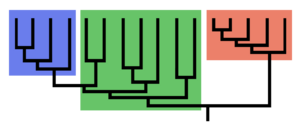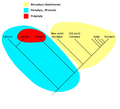Cladistics facts for kids

Cladistics is a way to group living things based on their shared ancestors. It helps us understand how different organisms are related through evolution.
A clade is a group that includes a common ancestor and all of its descendants. Think of it like a branch on a family tree that includes everyone who came from that one ancestor. The word 'clade' comes from Greek and means 'branch'. An English biologist named Julian Huxley first used this term.
Contents
What are Clades?
Imagine a family tree for animals. Birds, dinosaurs, and crocodiles all share a common ancestor. In cladistics, this entire group, including all their descendants (even those that are extinct), forms a clade.
Cladistics helps us classify living things in a way that matches their phylogeny (their evolutionary history). In this system, clades are the only acceptable groups for classification. This means that if a group doesn't include all descendants of a common ancestor, it's not considered a true clade.
How Cladistics Started
The idea of 'clade' was introduced in 1958 by Julian Huxley. The word 'cladistic' came along in 1960, and 'cladist' (for someone who follows this method) in 1965. The scientist who developed this approach, Willi Hennig, called his method 'phylogenetic systematics'.
For a long time, cladistics was not widely used. But in the 1990s, it quickly became the main way to classify living things in evolutionary biology. This happened because computers made it possible to study huge amounts of data about organisms and their features. Also, new ways to analyze biochemical and molecular information (like DNA) helped apply cladistics to more than just body parts.
Before cladistics became popular, some scientists used a method called numerical taxonomy. This method only looked at how similar organisms were, not their evolutionary relationships. This meant it didn't connect classification with evolution, which is a key part of cladistics.
Naming Groups with Cladistics
Phylogenetic nomenclature is a system for naming the clades found by cladistics. It's different from the older Linnaean system of naming. The main goal of this new naming system is to show how organisms evolved, based on what we currently understand.
Monophyletic and Paraphyletic Groups
In cladistics, a group is called monophyletic if it includes an ancestral species and all of its descendants. This is the definition of a true clade.
However, if a group includes a common ancestor but only some of its descendants, it's called paraphyletic. For example, reptiles are often considered a paraphyletic group because they don't include birds, even though birds evolved from reptiles.
The goal of cladistics is to identify and group organisms into monophyletic clades. This means that if a group is paraphyletic, its members need to be reorganized so they form one or more complete clades. When grouping organisms into clades, how similar they look is not the main rule; their shared ancestry is.
Related pages
Images for kids
-
A cladogram of primates, showing a monophyletic group (a clade: the simians, in yellow), a paraphyletic group (the prosimians, in blue), and a polyphyletic group (the nocturnal primates, in red).
See also
 In Spanish: Cladística para niños
In Spanish: Cladística para niños






